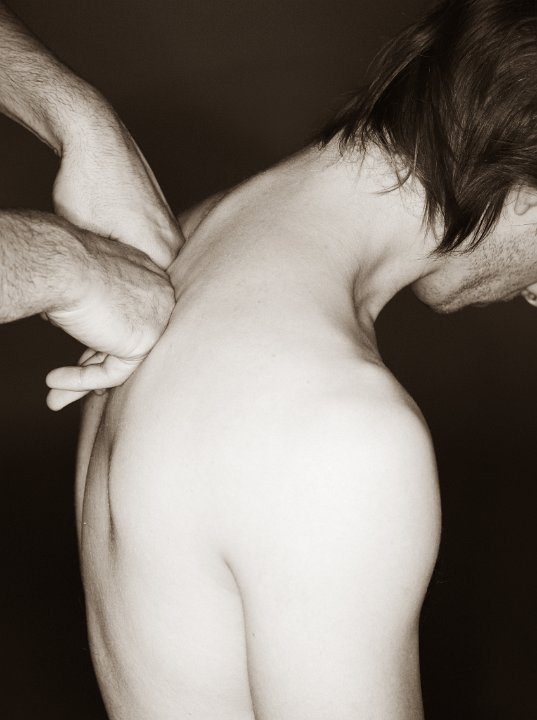What is Structural Integration?
Ida Pauline Rolf PhD is the mother of Structural Integration
Ida's inspiration
Dr Ida P. Rolf is the mother of Structural Integration. She was born in 1896 and obtained her doctorate in biochemistry from the College of Physicians and Surgeons of Columbia University. [1] During the late 1920's she started to struggle with spinal arthritis. Since there was little help available for her condition, in her willful and autonomous way, she began to explore ways to help herself.
It was this self exploration, a serious yoga practice, her background as a scientist, her study and work with a number of osteopaths and even her study of homeopathy that inspired Ida to develop the principles of Structural Integration.
From it's inception, Structural Integration has been transforming work. Ida's first attempt to help someone with manual work was "during the early war years." [2]
In 1940 she met a music teacher named Ethel who had fallen in a hole in New York City. Ida wanted her to teach her children but Ethel was too badly injured to work. She made a deal with Ethel:
"'I'll make a bargain with you. If I can get you to the place where you can teach music, will you teach my children?' She said yes. And so I started in. I started, really, with yoga exercises, which I myself was using at that point. After we worked together about four times, she was in good enough shape to start teaching music... Ethel had a friend who hadn't been able to get help, and this friend had a friend, and so forth. And from then on, my doorstep was pretty much filled with people who hadn't gotten help elsewhere." [2]
From Ethel on, people all over the world have undergone deep and meaningful change through Structural Integration.
Defining Structural Integration
Using manual techniques SI practitioners mold the human structure by lengthening, broadening, differentiating, lifting, opening or even awakening connective tissue that is short, stuck, positioned long, asleep or glommed onto other tissue or bone. They use their fingers, hands or forearms to gently sculpt your body around a vertical line of gravity. You will be encouraged to fully participate in the work. So an SI practitioner will cue you to move in subtle ways to draw connective tissue through their shaping pressure. During the work you may be lying on a therapy table with your knees up or just flat, seated on a bench, standing or walking.
Practitioners use movement reeducation and language that encourages awareness to help you find the best place for you to be in gravity.
Tom Myers, one of Ida's students, defined Structural Integration as a manual therapy that "seeks to organize the body closely around the vertical line of gravity and lengthen it along that line." [1] While this definition fits like a glove around the more mechanical aspects of the work, there are wider benefits derived in the process. Tom Meyers also delineated these:
"The scope of inquiry of SI is thus very wide, considering issues of evolution and maturational development, authentic self expression, the relationship between spatial arrangement and physiology, and of course the details of biomechanics." [1]
Structural Integration is indeed transformative work - the effects of which can be sensed a year or more after the work is complete. The discipline itself is quite sculptural. Structural Integrators are interested in the how your connective tissue (or fascia) and bone, nerves muscle and viscera are behaving.
“We want to get a man out of the place where gravity is his enemy”
The Recipe and Variations
So SI practitioners will frequently refer to the work as a Ten Series or a Twelve Series.
In addition to the Rolf Institute other official SI schools and disciplines are the Guild for Structural Integration, Hellerwork, Soma, CORE, Zen Therapy, ISI, Postural Integration, the Structural Integration Institute, Anatomy Trains School for Structural Integration (formerly KMI), Institute for Structural Medicine, and Mana.
The umbrella organization for all these schools is The International Association of Structural Integrators or IASI. Practitioners can register and or complete a Board Certification test with IASI.
Dr Rolf designed a multi session protocol for applying the principles of SI which came to be called a "recipe" by her students. Each session is part of one "Structural Integration Series." In Ida's "recipe" there are ten sessions in a Series. Each session has a theme or headline. For example, in Session One a main goal is to "open the breath." The power behind this progression is seen when a body systematically unveils and then resolves aberrant patterns. To the SI practitioner this process may have the look and feel of an elegant, opening Chinese puzzle. Thus the work is applied with nuance and strong intent.
Since Ida Rolf's death in 1979, various schools have developed their own slight variations of her recipe. Each Structural Integration school teaches the Series as either ten, eleven or twelve sessions.
[1]Myers, Thomas W. “Structural Integration - Developments in Ida Rolf's 'Recipe' - 1.” Journal of Bodywork and Movement Therapies, vol. 8, no. 2, 2004, pp. 131–142., doi:10.1016/s1360-8592(03)00088-3.
[2] Rolf, Ida Pauline, and Rosemary Feitis. Rolfing and Physical Reality. Healing Arts Press, 1990


